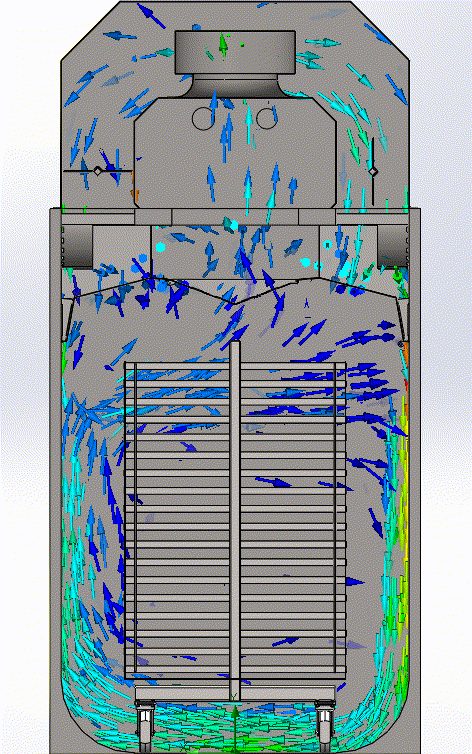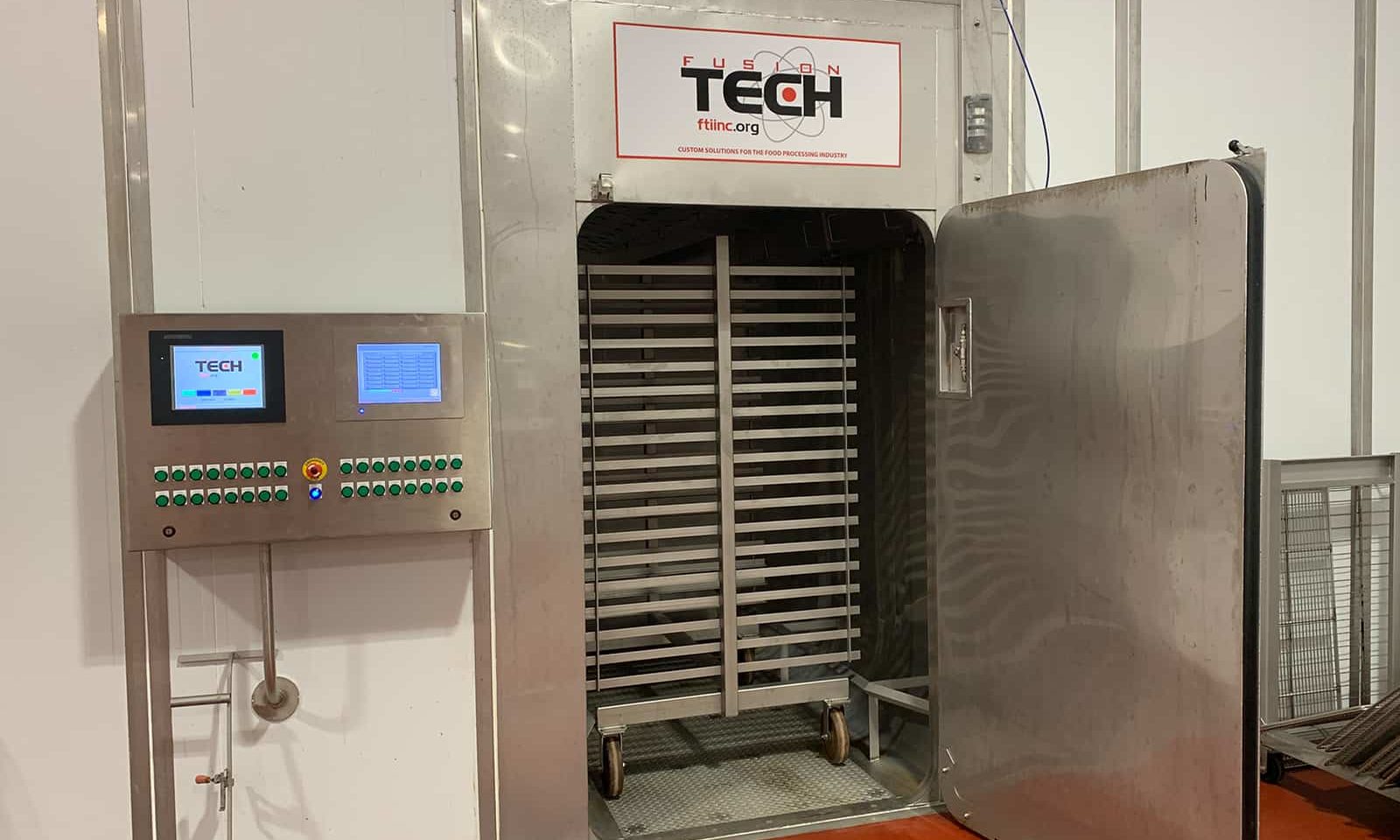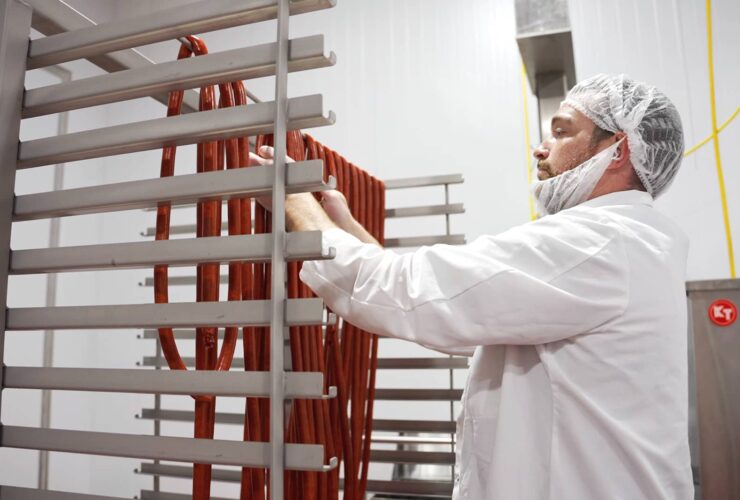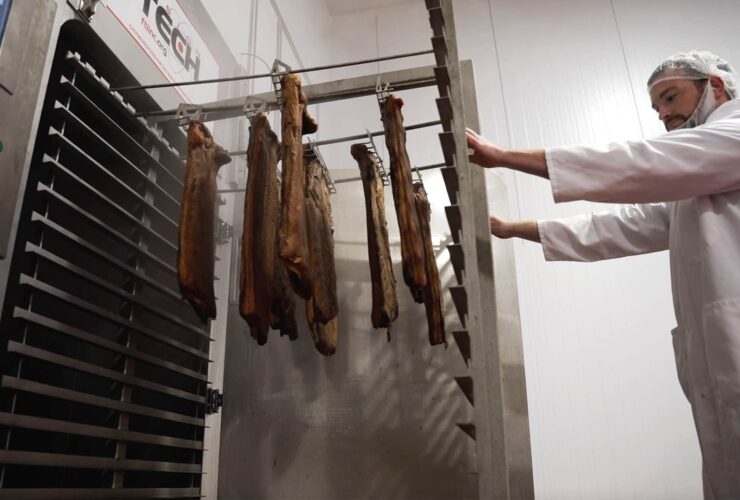The airflow, or more specifically the breakpoint, is the most important feature in any smokehouse or dehydrator.
This one feature alone is what cooks product in the oven — and is ultimately responsible for product yields, consistency, and color, as well as cook time.
If you want to improve product yields, consistency, or color, it all starts with being able to improve and control the breakpoint. The more control you have to set the location and duration of the breakpoint in any one specific spot in the oven, the greater your yields and consistency. The opposite is also true: the inability to control the location and duration of the breakpoint in an oven will always result in less than optimal yields and consistency.
It seems to reason then that the design of the oven cabinet should help strengthen and improve the breakpoint.
Strengthening the Breakpoint
One of the ways to strengthen the breakpoint in a smokehouse or dehydrator deals with the corner angle between the sidewalls and floor.
When air moves inside an oven, it needs to flow easily and unobstructed. Any obstacles or sharp angles in the path of where the air flows will either cause the air to stop, move in a different and unwanted direction, or greatly degrade the velocity of the air.
Think of it like dumping water down the walls of the oven. A 90° angle will cause water to hit the floor, splash all over, and slow down as it moves across the floor. A 45° angle helps a bit — water will still hit the angle, splash a bit, and slow down, but not as intensely as a 90° angle.
The same is true with airflow.
Most ovens feature a 90° or a 45° corner angle between the sidewalls and floor — creating “splash” zones that slow down the air and toss it throughout the oven.
The better solution is to create a radius, or cove, in the corner that gently directs air to flow across the floor and up the other side of the oven wall to create the breakpoint.
Why are Coves so Great?
These radiuses, or coves, are proven to strengthen and improve the breakpoint, resulting in better yields, consistency, and color in your product over ovens with a 45° or 90° angle.
Want proof? We ran two simulations to see which style of the corner allows the air to flow better: a coved corner or an angled corner.
Everything else in the simulations was the same — supply and return duct design, smokehouse truck design, airflow speed, and velocity coming out of the fan and into the supply duct. The only thing different was the corners.
Just look at the difference in how air flows with a 90° or 45° angle and a cove:


Stronger Airflow Velocity
As you can see in the two airflow simulations above, coved corners keep the airflow velocity from degrading as quickly as 90° or 45° angles.
This is important to forming a strong breakpoint. The high-velocity air needs to be able to make it down the oven wall, across the floor, and up the opposite wall in order to meet the low-velocity air and shoot across the truck to cook product.
If the high-velocity air is hindered and degraded, the point where it hits the low-velocity air will change, and it won’t be strong enough to make it across the truck before being sucked back in the return duct.
This is why most ovens experience a “cold” spot in the upper middle of the truck — the breakpoint just isn’t strong enough to carry across the full width of the truck because the high-velocity air was degraded.
Stronger Breakpoint
The stronger the airflow velocity, the stronger the breakpoint.
The breakpoint is the place in the oven where the high-velocity airflow (the air that flows across the floor and to the opposite wall of the oven) and the low-velocity airflow collide and move across the oven truck.
When the high-velocity airflow is weakened by obstacles or angled corners, it doesn’t have enough strength to get as high up the opposite wall. This results in the breakpoint not getting to the top of the truck, and not being strong enough to move across the full width of the truck.
As you can see in the airflow simulation of the angled corners, the breakpoint doesn’t make it all the way across the oven truck at the same rack level where it started. This means the product on that rack-level won’t cook consistently.
Easier to Control the Breakpoint Location
When the high-velocity airflow is strong, it allows you to better control where the breakpoint will occur in the oven.
Introducing obstacles or sharp angles in the path of the airflow will cause degradation — and it’s near impossible to control airflow consistently when it degrades, as airflow doesn’t degrade at the same rate each time.
You can see in the angled corner simulation that the air gets tossed around a lot after it hits the first corner, and the breakpoint (where the two airstreams meet) is wider and less focused than in the coved corner simulation.
The less focused the breakpoint, the less chance you have to get the breakpoint to hit that exact same spot with the same velocity every time — resulting in inconsistent yields.
The stronger the high-velocity airflow and the stronger the breakpoint means the better chance you have of controlling where the breakpoint will hit each time.
Air Stays Across the Bottom of the Oven
Coved corners have another benefit over angled corners: the high-velocity airflow stays across the bottom of the oven, rather than working its way up into the corner of the truck.
This has two main results that can be seen in the airflow simulations:
Airflow velocity is stronger
In the angled corner simulation, the velocity of the airflow degrades significantly once it hits the corner of the truck. There is almost an immediate change from light blue to dark blue, signifying a drop in speed and velocity.
In the coved corner simulation, the airflow remains strong – keeping even some green arrows all the way up to the breakpoint.
As we covered earlier, the stronger the airflow means the stronger the breakpoint, which results in a more consistent product.
Product doesn’t overcook on the bottom of the truck
Chances are if you have an oven with an angled corner, you’ve experienced product overcooking on the bottom corners of your truck.
The reason behind that is simple: the angled corners push air across product on the bottom of your truck during the entire cook cycle. Where product on the rest of the truck is only cooked when the breakpoint moves across that rack level, the bottom corners are buffered with air the entire time.
Coved corners help eliminate that issue by greatly reducing the amount of air that flows across the bottom of the truck.
And with the ability to place the breakpoint at any spot on the truck, you’re able to cook product at the top, middle, and bottom of the truck much more consistently.
Invest in the Only Oven with a Cove
Coved corners in a smokehouse or dehydrator greatly improve the airflow, producing a stronger, more controlled breakpoint. This in turn results in more consistent coloring and yields, giving you a better product that your customers will love.





